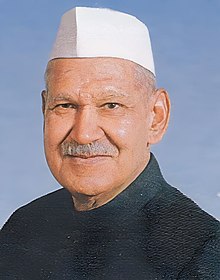
Back شانكار دايال شارما Arabic شانكار دايال شارما ARZ শঙ্কৰ দয়াল শৰ্মা Assamese शंकरदयाल शर्मा AWA Шанкар Даял Шарма Byelorussian শঙ্কর দয়াল শর্মা Bengali/Bangla Shankar Dayal Sharma Danish Shankar Dayal Sharma German ޝަންކަރް ދަޔާލް ޝަރްމާ DV Ŝankar Dajal Ŝarma Esperanto
Shankar Dayal Sharma | |
|---|---|
 Official Portrait, 1992 | |
| 9th President of India | |
| In office 25 July 1992 – 25 July 1997 | |
| Prime Minister | |
| Vice President | K. R. Narayanan |
| Preceded by | R. Venkataraman |
| Succeeded by | K. R. Narayanan |
| 8th Vice President of India | |
| In office 3 September 1987 – 25 July 1992 | |
| President | R. Venkataraman |
| Prime Minister | |
| Preceded by | R. Venkataraman |
| Succeeded by | K. R. Narayanan |
| Governor of Maharashtra | |
| In office 3 April 1986 – 2 September 1987 | |
| Chief Minister | Shankarrao Chavan |
| Preceded by | Kona Prabhakar Rao |
| Succeeded by | Kasu Brahmananda Reddy |
| In office 26 November 1985 – 2 April 1986 | |
| Chief Minister | Surjit Singh Barnala |
| Preceded by | Hokishe Sema |
| Succeeded by | Siddhartha Shankar Ray |
| 13th Governor of Andhra Pradesh | |
| In office 29 August 1984 – 26 November 1985 | |
| Chief Minister | |
| Preceded by | Thakur Ram Lal |
| Succeeded by | Kumudben Manishankar Joshi |
| 1st Chief Minister of Bhopal | |
| In office 31 March 1952 – 31 October 1956 | |
| Preceded by | Position established |
| Succeeded by | Position abolished |
| Cabinet Minister, Government of Madhya Pradesh | |
| In office 1956–1967 | |
| Departments | Education, Law, Public Works, Revenue, Industry and Commerce. |
| President of Indian National Congress | |
| In office 1972–1974 | |
| Preceded by | Jagjivan Ram |
| Succeeded by | Devakanta Barua |
| Personal details | |
| Born | 19 August 1918 Bhopal, Bhopal State, British India (now Madhya Pradesh, India) |
| Died | 26 December 1999 (aged 81) New Delhi, India |
| Political party | Indian National Congress |
| Spouse | |
| Children | 2 sons, 2 daughters |
| Alma mater | |
| Profession | Lawyer, Politician |
| Signature | |
Shankar Dayal Sharma (; 19 August 1918 – 26 December 1999) was an Indian lawyer and politician from the state of Madhya Pradesh who served as the ninth president of India, from 1992 to 1997.
Born in Bhopal, Sharma studied at Agra, Allahabad and Lucknow and received a doctorate in constitutional law from the University of Cambridge and was a bar-at-law from Lincoln's Inn and a Brandeis Fellow at Harvard University. During 1948–49, Sharma was one of the leaders of the movement for the merger of Bhopal State with India, a cause for which he served eight months' imprisonment.
A member of the Indian National Congress party, Sharma was chief minister (1952–56) of Bhopal State and served as a cabinet minister (1956–1971) in the government of Madhya Pradesh holding several portfolios. Sharma was president of the Bhopal State Congress Committee (1950–52), Madhya Pradesh Congress Committee (1966–68) and of the All India Congress Committee (1972–74). He served as Union Minister for Communications (1974–77) under Prime Minister Indira Gandhi. Twice elected to the Lok Sabha, Sharma served as governor of Andhra Pradesh (1984–85), Punjab (1985–86) and Maharashtra (1986–87) before being elected unopposed as the eighth vice president of India in 1987.
Sharma was elected president of India in 1992 and served till 1997 during which period he dealt with four prime ministers, three of whom he appointed in the last year of his presidency. He was assertive with the P. V. Narasimha Rao ministry, forcing his government to sack a governor, instigating a strong response to the demolition of the Babri Masjid and refusing to sign ordinances presented to him on the eve of elections. His appointment of Atal Bihari Vajpayee as prime minister on the grounds of him being the leader of the largest party in the Parliament attracted widespread criticism especially as Vajpayee was forced to resign in only thirteen days without facing a vote of confidence. Sharma's appointment of H. D. Deve Gowda and I. K. Gujral as prime ministers followed the assurance of support to their candidature by the Congress party but neither government lasted more than a year. Sharma chose not to seek a second term in office and was succeeded to the presidency by K. R. Narayanan.
Sharma died in 1999 and was accorded a state funeral. His samadhi lies at Karma Bhumi in Delhi.
© MMXXIII Rich X Search. We shall prevail. All rights reserved. Rich X Search